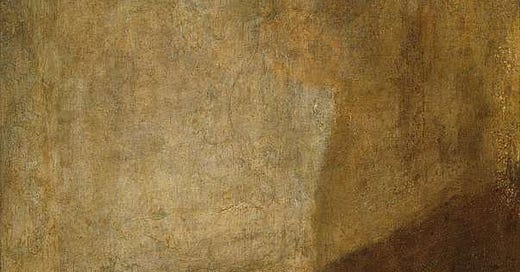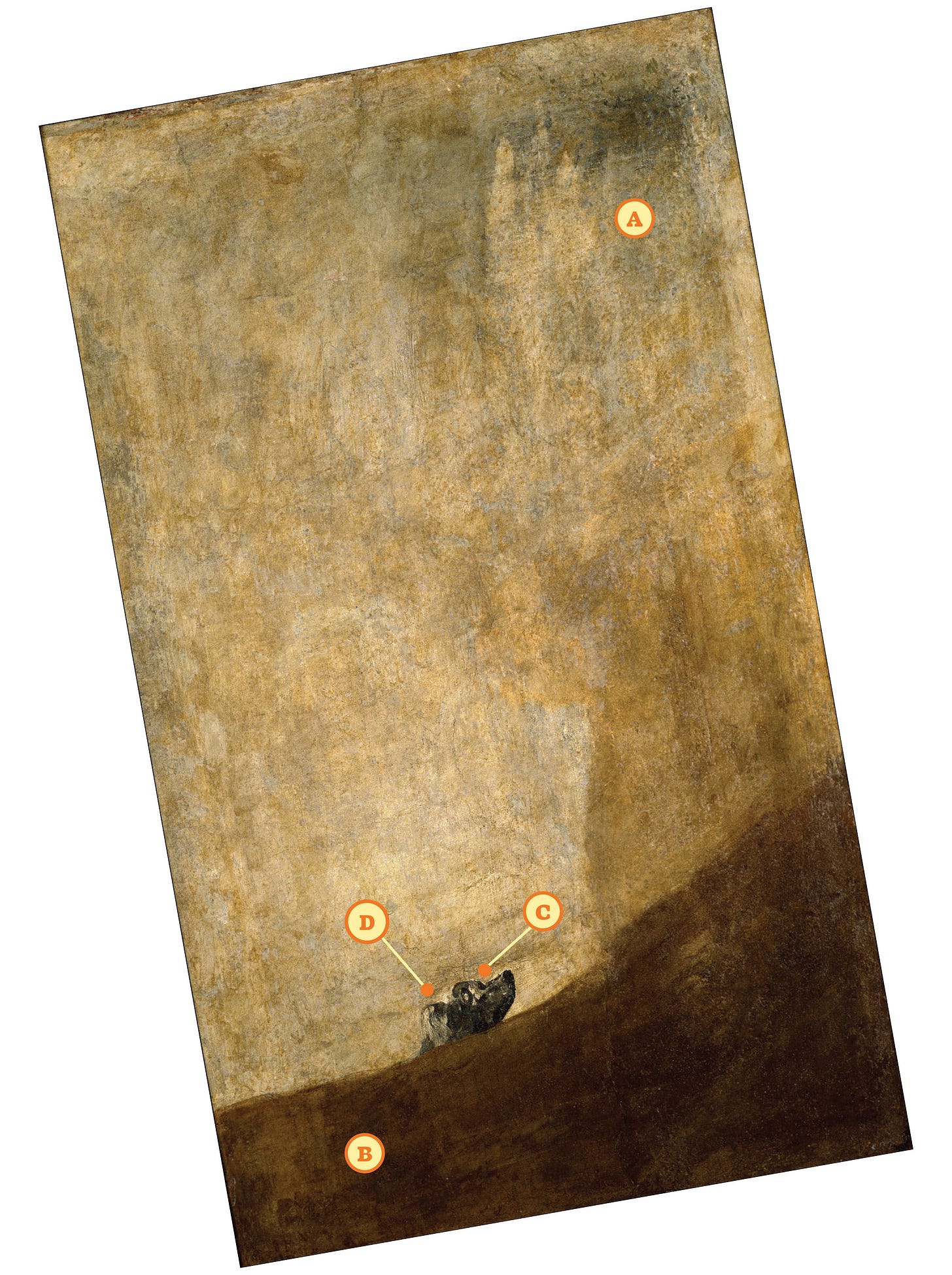Goya's Black Dog, by Clement Gelly
"It was only while gazing at 'The Dog' that I could feel anything at all."
This is entry #8 of Know-It-All, a zine about obsession and fandom. In this essay, Clement Gelly writes about becoming a “supplicant” of Francisco Goya’s painting “The Dog.” Know-It-All zine is best read in print. To order a copy, go here.
My first encounter with Francisco de Goya’s Black Paintings was in a small, quiet room of Madrid’s El Prado museum. The two larger walls on either side of the entrance displayed Goya’s gray-black scenes of cackling witches, satanic rituals, and wide-eyed giants consuming corpses. In the middle, directly across from me as I walked in, the first painting that my eyes landed on, was “The Dog.”
Goya originally painted the Black Paintings directly onto the plaster walls of his house when he was in his mid-seventies, and they were not known to art historians until some fifty years after his death. Goya painted these painful, violent scenes after losing children to miscarriage and infant death, after losing his hearing, after surviving the Inquisition, after living through the Napoleonic Wars, after rounding the last corner of his life and catching sight of his own imminent mortality.
This is why “The Dog” stands out so powerfully. Nowhere else in the Black Paintings, nor in the rest of Goya’s work, do we see such minimal, expressionistic tenderness. Viewing this painting among the violent surroundings of the others in the series, it felt to me like Goya needed “The Dog” as counterpoint.
I bought a poster that I took home with me and hung at the foot of my bed. The painting stayed there for a year and a half as a small comfort and reminder of my trip. Then, in December 2023, I survived a mass shooting at my university. My proximity to this meaningless, terrible violence called up Goya’s scene of two men beating each other senseless in one of the Black Paintings. Afterwards, I felt numb and distant from everything. It was only in my bedroom, gazing at “The Dog,” that I could feel anything at all.
I sat for hours at the foot of my bed, staring at it. It was mysterious, somehow religious. I learned everything I could about it. I read biographies of Goya, I looked through catalogs of his complete works, I read art theory and criticism. I stared long and hard at the painting, and, when I came across dogs in real life, I stared long and hard at them. I wanted to understand why this image had so much to say to me. Manuela Mena, a curator at El Prado, once wrote, “There is not a single contemporary painter in the world who does not pray in front of ‘The Dog.’" I’m not a painter, but I counted myself amongst the supplicants.
A
The dog gazes up at this dark spot like an anti-sun, casting rays of shadows through the ochre sky. It’s an ugly yellow, like urine or sweat stains. On the canvas at El Prado, this spot is three-dimensionally gnarled—it appears cracked and almost mildewed—a texture that reproductions of “The Dog” cannot capture.
In order to be displayed at El Prado, the Black Paintings were carved off of the plaster walls of Goya’s house and transferred to canvas. Some of the depth of “The Dog” comes from the damage this produced. The paintings were also re-framed, and liberally restored. Black and white photos of the paintings in situ from 1874 show them in their original, unaltered state. The brush strokes are more deliberate and delicate than what we see. In the case of “The Dog,” there is a much more defined shadow where the dog appears to be gazing—what could almost be a man kneeling. The series was also painted on the walls of two separate rooms, and “The Dog” was not the centerpiece, as it is arranged in El Prado.
What I saw at El Prado, what gave me hope in my bedroom, was not Goya’s work alone. It had been modified by several generations of conservators, curators, and interpreters. Goya once wrote of restoration that “it is not easy to retain the instantaneous and momentary intention of fantasy” of the original; far easier that the “retouches do… harm.” Goya would likely see our present “Dog” as an irreparably damaged version of his original genius. And yet, for better and for worse, this is “The Dog” that moved me.
B
Goya never titled these works, and so experts still quibble over the names. “The Dog” is most popularly known as “The Drowning Dog” or “The Half-Drowned Dog.” This takes the dog’s gaze to be one of panic, its legs paddling vainly beneath a wave of filthy brown water soon to come crashing down on our dog’s head.
One of the core curatorial interpretations behind the Black Paintings as we see them now is that Goya painted these works for no one but himself, through obsessive compulsion as he floundered in isolation and grief. But here I think Goya’s interpreters do his work a disservice.
Surely Goya did suffer as he made these: his sketchbooks at the time document his regular nightmares. He was haunted. But in his letters to friends he appears upbeat and outgoing. He had recently taken a new lover. Some contemporary historians now argue that the Black Paintings were actually Goya’s version of a phantasmagoria, a genre of traveling exhibition popular at the time where viewers could see gruesome paintings in dimly lit rooms to shock and titillate them. He may have even charged visitors a small fee to see them.
If the Black Paintings were solitary acts of desperation then, they were not only that; he worked for an audience, to speak to them and move them. Despite everything, he was still reaching out.
I don’t see the dog drowning. I see the dog resting its head on the edge of some support, in the way that in repose a dog’s head always seems a little too heavy. They, like us, need a friendly knee upon which to drool or a gentle hand to cup under their snout.
C
The dog’s eye is cartoonishly large, just as the faces and figures of the rest of the Black Paintings are cartoonishly warped and squashed. This is typical of Goya’s later work, in which he merges the language of the comic with the theme of the horrific. We see this in his May 2nd/May 3rd paintings, in his sketchbooks, in his etching “Loyalty” from the late 1810s, in which grotesque spectors inveigh on a tortured man, who is protected only by a barking dog at his side. By oscillating between horror and comedy, Goya plays with masks and exaggeration, and traces the way that our ideas and realities can match up, then separate, and then come back together. Sometimes a dog is just a dog, and sometimes it is the idea of a dog. Sometimes the dog is a dog and sometimes it is “The Dog.”
D
Goya had many dogs throughout his life, especially for hunting, and dogs are a frequent motif throughout his art. In each instance, the dogs have all the emotion and character of their human counterparts: anxious or sardonic, stern or beatific.
What’s certain is that the dog doesn’t know the churches and regimes and courtiers that Goya knew. Neither does it know the industrial revolution, civil war, or dictatorship that Goya’s conservators have known. But the dog knows the grief and love of the everyday: he is anguished and despondent the moment his owner steps out, overcome with joy when the owner returns.
“The Dog” was not originally the centerpiece of Goya’s Black Paintings, and yet for me, it always will be. “The Dog” seems to say that the vulnerable love of a pet is as reliable as life is horrific.
Clement Gelly is a writer and artist based in São Paulo, Brasil.



